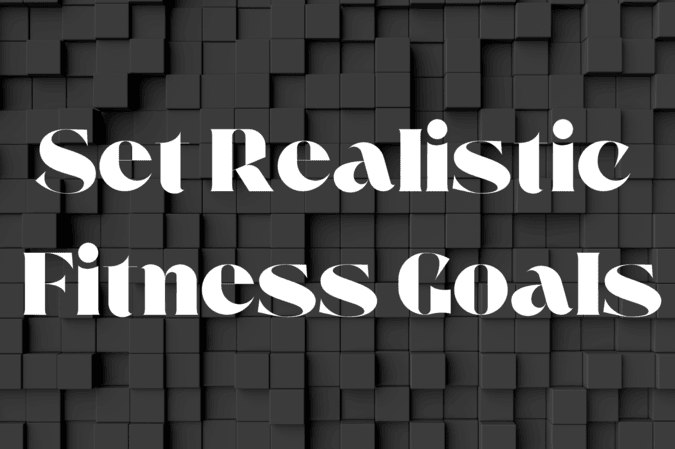Any fitness process requires the establishment of fitness goals yet people make their most significant mistake when creating unrealistic or too general targets.
Whether you’re just starting or looking to take your fitness to the next level, setting achievable goals will keep you motivated and increase your chances of long-term success.
In this blog, we’ll go over practical strategies to create realistic fitness goals, stay motivated, and track progress effectively.
Join In Shape and Spirit online fitness sessions to set and achieve realistic fitness goals! Our expert-led workouts and goal-setting strategies will keep you motivated. Track your progress, stay accountable, and celebrate your milestones. Start your journey today and transform your fitness with us!
1. Set SMART Goals

Success becomes most achievable through establishing SMART goals which are Specific, Measurable, Achievable, Relevant, and Time-bound. Let’s break it down:
Specific: You need to specify precisely the outcome you want to achieve in your goal. Use specific wording to replace general statements by setting your fitness goal as “Running a 5K.
Measurable: Your goal needs to be measurable because this quality allows you to monitor your progress. The target consists of losing 10 pounds throughout three months.
Achievable: The achievement of realistic goals depends on setting practical objectives. New runners should avoid attempting a marathon in thirty days as it exceeds their current capabilities.
Relevant: The goal needs to be in line with your lifestyle and personal interests. People who enjoy swimming will gain more satisfaction from working on lap performance improvements rather than weightlifting.
Time-bound: Set a deadline. The specific timeframe is set at four weeks to achieve 10 push-ups.
Example of a SMART Goal:
“I will work out for 30 minutes, five times a week, for the next two months to improve my cardiovascular endurance.”
2. Break It Down into Small Steps

The size of major aims can be overwhelming yet you can reduce them into several achievable steps. A six-month weight loss target should be divided into monthly goals that amount to 3-4 pounds of weight reduction. Quitting turns small achievements into building momentum that drives your motivation forward.
3. Track Your Progress

The fitness apps MyFitnessPal, Strava, Fitbit enable users to track workouts together with following their daily caloric consumption.
Individuals should keep a journal for documenting their exercise routines and dietary intake and daily energy changes.
The use of progress photos enables you to track visual changes in your body.
The tracking of inches lost is done through body measurements.
4. Stay Motivated with Rewards and Accountability

Celebrate Small Wins: Make a tradition of acknowledging each step forward since each achievement counts as a win. Treat yourself with either a physical workout outfit or a massage or an outdoor enjoyment.
Find a Workout Buddy: Exercise becomes more manageable when you partner with a workout friend.
Join a Community: Participate in a supportive community through live online fitness classes or personal trainers to receive motivational assistance.
My Personal Experience:
I established the objective to perform 20 straight push-ups three years back. I first managed to perform only five push-ups at the start. I chose to stay motivated through small and consistent improvements by adding an additional push-up repetition every several days. After six weeks I succeeded in completing 20 push-ups during my single push-up set. The results of this experience showed me how steady effort and progressive steps produce major outcomes.
Client Success Story:
My client, Sarah decided she needed to shed off 30 pounds through a six-month period. We divided the entire weight loss goal into monthly sub-goals of five pounds each. The first step was daily walking followed by the introduction of strength training exercises to her routine. Following each achievement with careful measurement she managed to eliminate her excess weight and build confidence with increased strength.
Establishing practical fitness targets remains essential to achieving sustainable achievements.
The SMART goal process combined with progress tracking and small victory celebration makes it possible to stay motivated throughout your fitness journey.
Take the first step right now because small progress brings big results while you experience the path toward becoming your healthier and stronger self.
You may also want to see our beginners guide on how to start your fitness journey and Seamlessly Integrating Yoga into Your Daily Routine for a Healthier, Happier Life, Unlock Your Fitness Potential with HIIT: Why Everyone Should Try It, Dance Workouts: A Fun and Powerful Way to Get Fit, The Transformative Power of Strength Training: Building Muscle, Boosting Metabolism, and Elevating Health, Unlocking Your Potential with Virtual Fitness Training
We hope that this article helped you learn How to Set Realistic Fitness Goals and Achieve Them. You can follow us on Facebook and Instagram for more helpful content.

